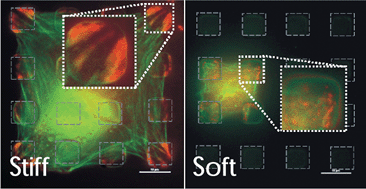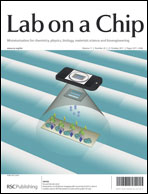Assessing the spatial resolution of cellular rigidity sensing using a micropatterned hydrogel–photoresist composite
Abstract
The biophysical machinery that permits a cell to sense substrate rigidity is poorly understood. Rigidity sensing of adherent cells likely involves traction forces applied through focal adhesions and measurement of resulting deformation. However, it is unclear if this measurement takes place underneath single focal adhesions, over local clusters of focal adhesions, or across the length of the entire cell. To address this question, we developed a composite, chip-based material containing many arrays of 6.5 μm × 6.5 μm rigid adhesive islands, with an edge–edge distance of 8 μm, grafted onto the surface of a non-adhesive polyacrylamide hydrogel. This material is thus rigid within single islands while long-range rigidity is determined by the hydrogel. On soft gels, most NIH 3T3 cells spread only across two islands in a given dimension forming small stress fibers and focal adhesions. On stiff gels, cell spreading, stress fibers, and focal adhesions were indistinguishable from those on regular culture surfaces. We conclude that rigidity sensing is dictated by material compliance across the cell length and that responses to rigidity may be inhibited at any point when large substrate strain is encountered during spreading. Our finding may serve as a guideline for the design of biomaterials for tissue engineering.


 Please wait while we load your content...
Please wait while we load your content...